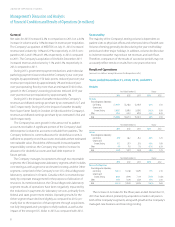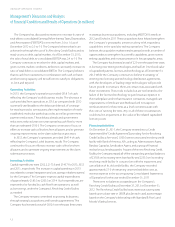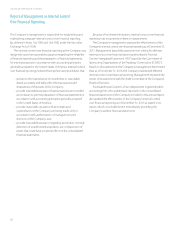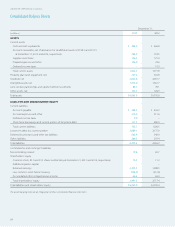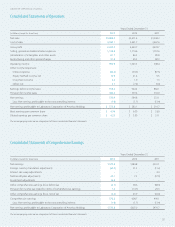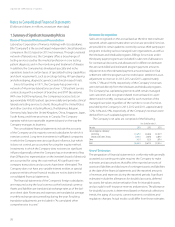LabCorp 2013 Annual Report Download - page 22
Download and view the complete annual report
Please find page 22 of the 2013 LabCorp annual report below. You can navigate through the pages in the report by either clicking on the pages listed below, or by using the keyword search tool below to find specific information within the annual report.18
LABORATORY CORPORATION OF AMERICA
Management’s Discussion and Analysis
of Financial Condition and Results of Operations (in millions)
Accruals for Self-insurance Reserves
Accruals for self-insurance reserves (including workers’ compensation,
auto and employee medical) are determined based on a number
of assumptions and factors, including historical payment trends and
claims history, actuarial assumptions and current and estimated
future economic conditions. These estimated liabilities are
not discounted.
The Company is self-insured (up to certain limits) for professional
liability claims arising in the normal course of business, generally
related to the testing and reporting of laboratory test results. The
Company maintains excess insurance which limits the Company’s
maximum exposure on individual claims. The Company estimates
a liability that represents the ultimate exposure for aggregate
losses below those limits. The liability is discounted and is based
on actuarial assumptions and factors for known and incurred but
not reported claims, including the frequency and payment trends
of historical claims.
If actual trends differ from these estimates, the financial results
could be impacted. Historical trends have not differed materially
from these estimates.
Income Taxes
The Company accounts for income taxes utilizing the asset and
liability method. Under this method deferred tax assets and liabilities
are recognized for the future tax consequences attributable to
differences between the financial statement carrying amounts of
existing assets and liabilities and their respective tax bases and for
tax loss carryforwards. Deferred tax assets and liabilities are mea-
sured using enacted tax rates expected to apply to taxable income
in the years in which those temporary differences are expected to be
recovered or settled. The effect on deferred tax assets and liabilities
of a change in tax rates is recognized in income in the period that
includes the enactment date. The Company does not recognize
a tax benefit, unless the Company concludes that it is more likely
than not that the benefit will be sustained on audit by the taxing
authority based solely on the technical merits of the associated tax
position. If the recognition threshold is met, the Company recognizes
a tax benefit measured at the largest amount of the tax benefit that
the Company believes is greater than 50% likely to be realized. The
Company records interest and penalties in income tax expense.
Goodwill and Indefinite-Lived Assets
The Company assesses goodwill and indefinite lived intangibles
for impairment at least annually and more frequently if triggering
events occur. The timing of the Company’s annual impairment
testing is the end of the fiscal year. In accordance with the Financial
Accounting Standards Board (“FASB”) updates to their authoritative
guidance regarding goodwill and indefinite-lived intangible asset
impairment testing, an entity is allowed to first assess qualitative
factors as a basis for determining whether it is necessary to perform
quantitative impairment testing. If an entity determines that it is
not more likely than not that the estimated fair value of an asset is
less than its carrying value, then no further testing is required.
Otherwise, impairment testing must be performed in accordance
with the original accounting standards. The updated FASB guidance
also allows an entity to bypass the qualitative assessment for any
reporting unit in its goodwill assessment and proceed directly to
performing the first step of the two-step assessment. Similarly, a
company can proceed directly to a quantitative assessment in the
case of impairment testing for indefinite-lived intangible assets
as well. In 2013 and 2012, the Company elected to bypass the
purely qualitative assessments for its goodwill and indefinite-lived
intangible assets and proceed to quantitative assessments utilizing
methodologies as described in the following paragraphs.
Step One of the goodwill impairment test includes the estimation
of the fair value of each reporting unit as compared to the book
value of the reporting unit. The Company uses a market value approach
for determining fair value and utilizes a number of factors such as
publicly available information regarding the market cap italization of
the Company as well as operating results, business plans, and present
value techniques. If Step One indicates potential impairment, the
second step is performed to measure the amount of the impairment.
The Company has indefinite-lived assets consisting of acquired
Canadian licenses. When a quantitative analysis is considered
necessary for indefinite-lived intangible assets, the Company utilizes
an income approach to determine the fair value. It then compares
the carrying value of the indefinite-lived asset to its fair value.
Impairment losses are recorded to the extent that the carrying
value of the indefinite-lived intangible asset exceeds its fair value.
There are inherent uncertainties related to the factors described
above and judgment related to our impairment assessments of
goodwill and indefinite-lived intangibles. The assumptions underlying
the impairment analyses may change in such a manner that impair-
ment in value may occur in the future. Any such impairment will be
recognized in the period in which it becomes known.


